London is a big place, and navigating it can be confusing. It's been here for a couple of millennia (give or take a century or two) so it's not surprising the streets don't really follow a handy grid. In fact, it can be frustratingly rare to find an intersection (here called a "junction") where the streets meet at a 90 degree angle. It's much more likely that seven or eight will come together at once in an array of jaunty angles. This makes getting around a bit of a challenge, so it's very helpful to familiarize yourself with a few key landmarks to make it easier to get properly oriented in the mess. So today I offer up a primer of those London landmarks - big, tall, important, distinctive or all of the above. Here in Part One we’ll concentrate on the river and those landmarks lying to the north of it, indicated in blue on this lovingly constructed Google Map:
View London Landmarks in a larger map
First, the most significant geographical feature of the city:
The River Thames: I hope that you all, being smart enough to read this blog in the first place, know that the correct pronunciation of the name of the river is "temz". Please, God, not with a soft "th" sound and/or rhyming with "games". Please. I'm begging you.
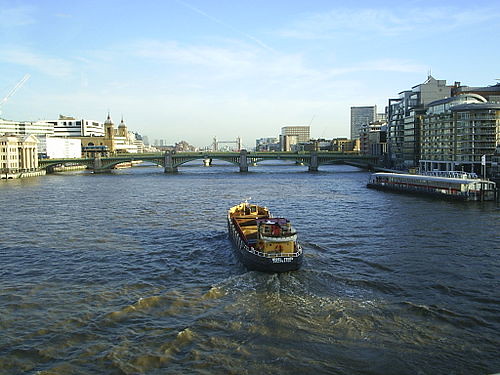
The importance of the Thames to London is monumental, since it’s probably the reason the city is here in the first place. Human habitation along the Thames dates back to somewhere around 3000 BC, evidenced by the discovery of a Neolithic bowel found in the river, and the Romans settled in the area near the current site of London Bridge, which they called Londinium, which is an amazing coincidence, don’t you think?
The Thames is tidal where it passes through London, rising and falling about 23 feet, which makes for some distinctly mucky views during low tide. It cuts through the city roughly west to east, with a great amount of meandering along the way. Most of the city lies to the north, with criminals, prostitutes and actors in the south. Oh wait - that's about a 500 year old distinction. Now it's perfectly lovely and respectable south of the river. I live there myself. However, there is still a lingering sense that anywhere south of the Thames is not quite so properly London as anywhere north. There are also fewer convenient transport links, but the real estate is cheaper.
Now picture yourself in the middle of Waterloo Bridge (the green splodge on the map) and rotate until you see this familiar feature:
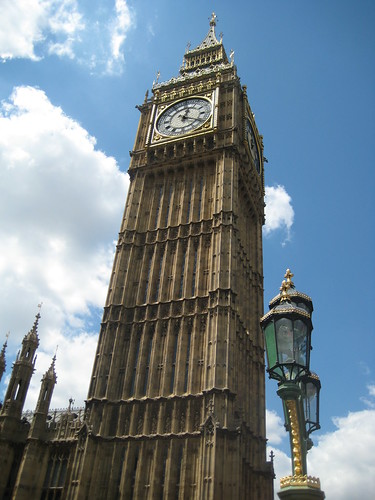 Big Ben: Located on the north side of the Thames at the foot of Westminster Bridge, the structure most people refer to as Big Ben is more properly know as the Clock Tower of the Palace of Westminster. (Big Ben is the name of the Great Bell – the one that tolls the hour.) It's the largest four-sided clock tower in the world, and the minute hand is about 14' long. I have never passed Big Ben, no matter what the time of day or night, without seeing tourists taking photos.
Big Ben: Located on the north side of the Thames at the foot of Westminster Bridge, the structure most people refer to as Big Ben is more properly know as the Clock Tower of the Palace of Westminster. (Big Ben is the name of the Great Bell – the one that tolls the hour.) It's the largest four-sided clock tower in the world, and the minute hand is about 14' long. I have never passed Big Ben, no matter what the time of day or night, without seeing tourists taking photos.
The tower itself was designed by Augustus Pugin, a different architect than the one who designed the surrounding palace. Fantastically, Wikipedia claims that “The design for the Clock Tower was Pugin's last design before his final descent into madness and death…” Nothing like a little madness and death the spice up a blog post. Even more fantastically, the clock movement (completed in 1858 and invented for this clock by amateur horologist Edmund Beckett Denison) is apparently regulated by a “double three-legged gravity escapement” which is simply too delicious for even me to make up. (Ian, care to chime in here?) (Ha. See what I did there? Chime in…). The clock is famously accurate, and even managed to continue to toll the hour throughout heavy bombing during the Blitz.
Ok, one more bit of clock trivia from our friends at Wikipedia before we move on:
“On top of the pendulum is a small stack of old penny coins; these are to adjust the time of the clock. Adding a coin has the effect of minutely lifting the position of the pendulum's centre of mass, reducing the effective length of the pendulum rod and hence increasing the rate at which the pendulum swings. Adding or removing a penny will change the clock's speed by 0.4 seconds per day.”
Now rotate about 90 degrees clockwise and perform a graceful and incredibly energetic leap and you should catch a glimpse of:
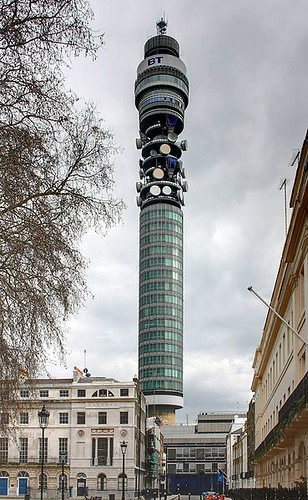
The BT (British Telecom) Tower: A 189m tall, skinny and somewhat inelegant structure opened in 1966 (and it looks like it) located just south and east of Regent's Park. Its first purpose was to house microwave aerials to support telecom traffic, and it was originally built by the General Post Office. (Many Londoners still call it the Post Office Tower.) It's now owned and occupied by BT, and is not open to the public.
I think the whole thing is a bit… "Jetsons". It’s as if the architect suddenly thought "Hey, we've been talking about the future for so long we must be in it! I'm going to design this building to look like THE FUTURE!" (I like to call this the "Winnipeg Clinic Building Effect"). Honestly, it looks like it should be tipped over and spinning slowly in the background of an episode of "Star Trek".
And now, a very odd bit of Wikipedia trivia about the BT Tower:

The BT (British Telecom) Tower: A 189m tall, skinny and somewhat inelegant structure opened in 1966 (and it looks like it) located just south and east of Regent's Park. Its first purpose was to house microwave aerials to support telecom traffic, and it was originally built by the General Post Office. (Many Londoners still call it the Post Office Tower.) It's now owned and occupied by BT, and is not open to the public.
I think the whole thing is a bit… "Jetsons". It’s as if the architect suddenly thought "Hey, we've been talking about the future for so long we must be in it! I'm going to design this building to look like THE FUTURE!" (I like to call this the "Winnipeg Clinic Building Effect"). Honestly, it looks like it should be tipped over and spinning slowly in the background of an episode of "Star Trek".
And now, a very odd bit of Wikipedia trivia about the BT Tower:
"Until the mid-1990s, the building was officially a secret, and did not appear on official maps. Its existence was finally "confirmed" by Kate Hoey, MP, on 19 February 1993: "Hon. Members have given examples of seemingly trivial information that remains officially secret. An example that has not been mentioned, but which is so trivial that it is worth mentioning, is the absence of the British Telecom tower from Ordnance Survey maps. I hope that I am covered by parliamentary privilege when I reveal that the British Telecom tower does exist and that its address is 60 Cleveland Street, London."
And yes, it had the mandatory rotating restaurant, though it's no longer open to the public and is only used for BT functions. In fact, London does not have a rotating restaurant at all, which makes you wonder how it can possibly claim to be a world class city. I mean really.
Now continue rotating clockwise until you see:
Now continue rotating clockwise until you see:
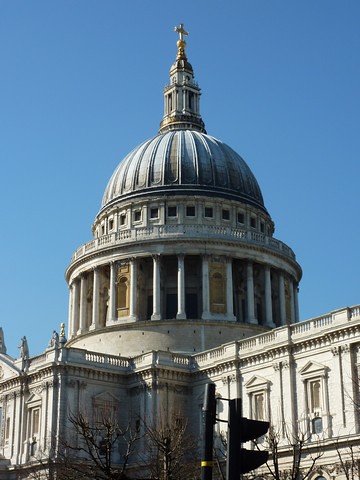 St. Paul's Cathedral: You've GOT to know this one, right? It's right up there with Big Ben among London Landmarks. The current St. Paul's was, of course, designed by Sir Christopher Wren, and was consecrated in 1708, though the site has been home to a St. Paul's of some form or other since 604 A.D.. (Yes that's 604, not 1604. I'm telling you, this city is OLD.) It was apparently the tallest building in London until 1962 and has been host to many important events in the history of the city and nation, including the funerals of Nelson, Wellington, and Churchill, jubilee celebrations for Queen Victoria and Queen Elizabeth, and the wedding of Charles and Diana.
St. Paul's Cathedral: You've GOT to know this one, right? It's right up there with Big Ben among London Landmarks. The current St. Paul's was, of course, designed by Sir Christopher Wren, and was consecrated in 1708, though the site has been home to a St. Paul's of some form or other since 604 A.D.. (Yes that's 604, not 1604. I'm telling you, this city is OLD.) It was apparently the tallest building in London until 1962 and has been host to many important events in the history of the city and nation, including the funerals of Nelson, Wellington, and Churchill, jubilee celebrations for Queen Victoria and Queen Elizabeth, and the wedding of Charles and Diana.Wren's St. Paul's was built on when the previous incarnation was destroyed by the Great Fire of 1666. It’s perhaps best know for its impressive dome, which is one of the tallest in the world and has an internal diameter of 225 feet. Around the inside of the dome, 99' from the floor is the famous Whispering Gallery which is so named "because, as with any dome, a whisper against its wall at any point is audible to a listener with an ear held to the wall at any other point around the gallery. A low murmur is equally audible." (Wikipedia)
Such is the perceived importance of St. Paul's to the British psyche, that during a bad period of the Blitz in WWII, Churchill is said to have decreed that "St. Paul's must be saved" to preserve the morale of Londoners. This meant that teams of volunteers patrolled the rooms, crypts and corridors of the cathedral with water pumps and sandbags to douse any fires that were started. In one particularly tense moment during a bombing raid on the night of Dec. 29, 1940, an incendiary device landed on the famous domed roof and started to melt through the lead covering, but luckily it dislodged itself and was smothered by workers on the ground. So St. Paul's is still standing today, having received surprisingly little damage compared to the rest of the city.
On with the show, and our last landmark north of the river. Rotate slightly towards the east and cast your eye further out, and it should come to rest on:
The Gherkin: Ah...the Gherkin. Or, as it is more mundanely known: 30 St.Mary Axe. Or, as it is much more cleverly known: The Crystal Phallus (ha!). You can see why:
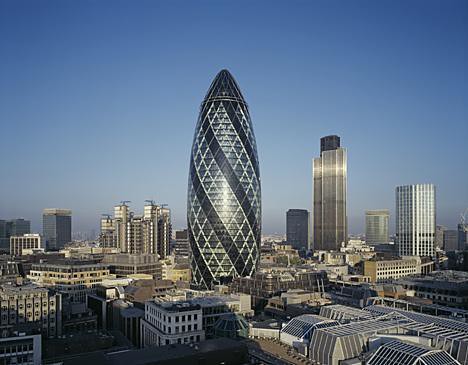
The Gherkin is a recent addition to the London skyline, officially opened in 2004, and reaching 180 metres in height. The site is the former home of the Baltic Exchange Building, which was badly damaged in a bombing by the Provisional IRA in 1992. Despite the desire to restore or rebuild the original building, damage to the structure was too great, and the façade and other important architectural details were salvaged and put into storage, paving the way for a completely new building. The unique shape of the Gherkin is an interesting departure for the city, and the design won many architectural awards for its design and sustainable energy features, including being named “the most admired new building in the world” according to a survey of architects in 2005.
But the most interesting bit of trivia I found about the building (on its own website no less) is this:
"During the early phases of construction, the grave of a teenage Roman girl was unearthed. After being sheltered in the Museum of London during the construction period, the grave was reinserted at the base of the skyscraper."
Cool.
And that’s it for north-of-the-Thames landmarks. Stay tuned for Part Two of the series, about the London landmarks south of the Thames, coming soon to a blog near you.



2 Comments:
Thanks Pam.
I always had it in my mind that Big Ben's escapement was a grasshopper and not a gravity. Apparently not! How embarrassing. It's got things going on that one. All legs and odd angles like a wild grasshopper. For a curious mind it's a brilliant thing to watch one of these mechanisms work, but so is the gravity escapement. Here's a clear animation of one in action.
http://en.wikipedia.org/wiki/Escapement#Gravity_escapement
I got up close and personal with a tower clock in Winnipeg that is installed in the tower at St. Luke's Anglican church in Osborne Village. Yum.
In 1976 Big Ben had a catastrophic failure. As I remember the story, one of the speed limiting flies near the end of a gear train failed. The mechanism was then free to speed up as the weights fell until the gearing finally flew apart under the stress.
I've always thought it would be fun to get up into that stone chamber and see the damage to the walls. Apparently there is plenty of impressive evidence of the gears ripping around the room at high rpm as it all came apart rather dangerously.
Wow - I haven't seen the Gherkin before! Guess I haven't been back to London since the early 2000's. Really stands out, huh?
Post a Comment